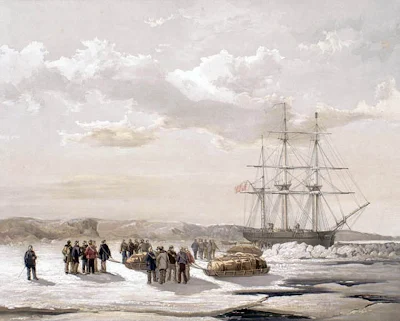Don Martin/National Post
The Mercy Bay encampment with a nearby grave site, Jul. 27, 2010. The HMS Investigator, whose crew discovered Canada’s Northwest Passage has been found 155 years after it was abandoned and disappeared in this isolated Arctic bay.
Don Martin, National Post · Wednesday, Jul. 28, 2010
Dangling precariously over the side of a Zodiac while peering into the blue-green Arctic Ocean, the wreck of the ghost ship HMS Investigator suddenly looms large just eight metres below the surface.
The pointed bow, the flat stern splintered long ago by a passing iceberg, and a section of railing draped across the middle are easily visible to the naked eye despite the salt water. His hand cupped to block out the sun’s reflection, the usually restrained Environment Minister Jim Prentice excitedly tried to describe what he was seeing. All he could manage was a gushing stream of adjectives punctuated by a whole lot of “wows.”
Goosebumps are inevitable when seeing a well-preserved wreck that is considered to be one of the most significant in the history of a country that didn’t exist when the British exploration vessel sank in 1855 after two deadly winters in this Banks Island Bay.
Until this week, no Canadian had set eyes on this incredibly well-preserved 36-metre, three-masted ship, which sank a year or so after being abandoned by Robert McClure and his crew, who are credited with finding the missing east-west link in the Northwest Passage.
The Parks Canada discovery last weekend happened almost too quickly for dramatic effect, perhaps befitting an archeological dig that is experiencing such an incredible streak of good luck on the water, on land and with the weather, the team is pinching itself in disbelief.
When a trio of Parks Canada archeologists took to their five-metre Zodiac earlier this week, dragging a torpedo-shaped Sonar gun behind them, they were prepared to spend two weeks scouring the bottom of the 30-metre-long bay. Even then, the odds of finding the Investigator were rated 50/50.
Spotting only one clear route through chunks of ice floating a few hundred metres off shore, they aimed their inflatable boat through the passage, flipped the switch to activate the Sonar, and turned their attention to the computer monitor.
The monochrome image almost immediately picked out bits of debris amid the deep gouges on the seabed before Canada’s echo of the Titanic discovery moment: The starboard of the Investigator appeared on the viewing screen.
The archeologists were sure they had it, but almost couldn’t believe a 10-month planning quest had succeeded so rapidly.
They made a second pass, then a third, a fourth, a dozen sweeps, and then — just one hour after they started — the team declared the Investigator found 155 years after it sank.
“Mercy Bay must feel like it got a bad wrap in the history books. It changed its nature and decided to be more merciful to us,” quipped Ryan Harris, a Parks Canada senior marine archeologist.
University of Western Ontario archaeologist Ed Eastaugh is scouring the land with magnetic scanners to record evidence of Investigator sailors who roamed the barren fields and fished the nearby lakes duringvwmore than two years trapped in the bay by thick ice.
His imaging team took just two days to find the three graves of British sailors who succumbed to sickness and starvation just a month before the boat was abandoned.
“You’re probably going to find a frozen body under there. This image [which shows up as three black rectangles against a faded background] suggests the bodies haven’t decomposed,” he said. “This was the needle in the haystack. This is what I had hoped to find above all else. I’ve never been on a project that has hit the principal goal so quickly.”
The giant cache of food, booze, barrels, pans and coal left behind by the Investigator crew before they walked to their rescue on the far side of nearby Melville Island has also been scouted and charted. A metal section holding a yard-arm in place and a metre-long piece of wood from the ship have been found on shore. Both items might be removed and taken to Ottawa for analysis and preservation.
Archeologists have also located a thousand-year-old Thule encampment on the far side of Mercy Bay, a rich deposit of tools amid hundreds of whale, caribou and seal bones. They hope to use the information gleaned from the site to plot and confirm the various migrations of indigenous people from Asia.
During a tour of the site yesterday, archaeologists showed me numerous bone fragments, a harpoon head and primitive tools found around the outlines of a large Thule dwelling and numerous food caches.
About the only setback so far was the temperamental behaviour of Little Bruce, a remote-operated vehicle the team lowered to video the wreck. It was reacting poorly to commands from the surface and the joystick will need to be replaced, but early glimpses of the wreck reveal the windlass and both anchor chains along with more detailed views of the deck.
The story appears to have captivated Britain, which still claims ownership of the wreck and the graves, almost as much as Canada.
The Environment Minister spent an entire morning fielding satellite calls from across the country, from international wire services, London newspapers and the BBC.











